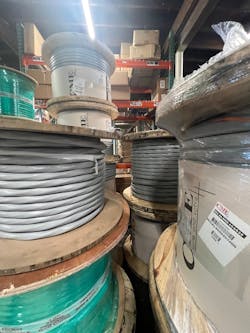The Apprentice’s Guide to Service Entrance Cable
One of the most essential Chapter 3 wiring methods for residential electricians in the National Electrical Code (NEC) is service entrance (SE) cable. Its primary purpose is to be used as a “main” feeder for the (building or premises) aerial service drop or underground feeder connection to dwelling units. This cable transports power from the utility company to the line side of the meter base — and then from the load side of the meter base to the breaker box or panelboard. It can be used in aerial (aboveground installations) as well as underground installations (if marked with SEU). Article 338 covers the use, installation, and construction specifications for SE cable, which is available as a single conductor or multiconductor assembly “with or without” an overall non-metallic sheathed covering.
Additional uses (it’s a multi-purpose cable)
In specific conditions, SE and SER may be used for branch circuits and feeders to electrical equipment indoors and outdoors as approved by the NEC. For example, in Sec. 338.10 (B)(2), SE cable is approved to be used as a branch-circuit feeder in existing installations; when the uninsulated grounded conductor of the cable originates from the service equipment, the uninsulated conductors “shall be permitted” to be used as a grounded conductor. It can be used in cable trays and for feeding electrical equipment such as electrical ranges (Art. 250.140, 210.19-A.3 Exception No. 2). Just make sure the wire material and insulation rating match your device or receptacle requirements. Basically, SE cable can be used in any application where it's permitted by the NEC; it can be used in wet or dry locations; the installation is rated for 600V or less; and the temperature does not exceed 90°C.
It has different styles
Service entrance cable Type SE is available as style SER and SE style U. Available in copper and aluminum, it's rated up to 600V, and the insulated (individual) conductors are covered with XHHW-2 or THHN/THWN. The gray jacketed-style cable has a flame-retardant, sunlight- and moisture-resistant polyvinyl chloride (PVC) outer jacket. In addition, a thin plastic reinforcement tape is wrapped around the conductors for added strength and conformity.
Type SEU cable has two insulated phase conductors surrounded by a concentric neutral. Type SER has three insulated conductors with an uninsulated grounding conductor. Type USE service-entrance cable is designed for underground use; it has a moisture-resistant covering but may not have a flame-retardant cover. For more information on the jacketing, see the Table below.
You can use it here
SE cable is permitted for use in the following:
Type I or Type II structures — When installed within raceways approved to be used in Type I (fire-resistive) construction (i.e., a building constructed of non-combustible materials, such as reinforced concrete, brick, stone, etc., and having any metal members properly “fireproofed” with major structural members designed to withstand collapse and to prevent the spread of fire).
Type II (non-combustible) construction — (i.e., a building having all structural members, including walls, floors, and roofs, of non-combustible materials (reinforced concrete, brick, stone, etc.) and not qualifying as fire-resistive construction).
TYPE III-A-protected combustible applications — Known as “ordinary” construction with brick or block walls and a wooden roof or floor assembly, which is 1-hour fire-protected.
Type IV buildings that have non-combustible exterior walls and interior elements. These buildings are made from solid or laminated wood. All wooden members must meet specific dimensional requirements (e.g., wood columns, beams, and girders must be at least 8 in. thick; heavy planks for floors and roofs must be at least 6 in. thick).
Type V applications — Structural elements, walls, arches, floors, and roofs are wood or other approved material.
Follow my column for more practical how-to articles and tips for applying electric basics concepts in the field Everyday Instructions for Electricians, Introduction to Commercial Service Calculations, Introduction to Residential Service Calculations, The Apprentice’s Guide to Non-Metallic Sheathed Cable, The Apprentice’s Guide to NEC Chapter 4, The Apprentice’s Guide to Art. 300, the The Apprentice’s Guide to Art. 640, and The Apprentice's Guide to Special Equipment. For more information on why a structured approach is so important to navigating the NEC and how to put its requirements into practice in real-world settings, read “The NEC for Newbies.”
Harold De Loach, a master electrician and electrical trainer/instructor, is the founder of The Academy of Industrial Arts (www.taia-school.com) in Philadelphia. With more than 30 years of experience in the field, he writes regular exclusive content for the E-Train and can be reached at [email protected].
About the Author
Harold De Loach
De Loach is the Director of Education and Training for the Leaders of Electrical License Preparation courses for Philadelphia and The Lehigh Valley (www.necprepclass.com). He is the founder and Director of The Academy of Industrial Arts L.L.C. (www.taia-school.com), a customized electrician training program that provides entry-level electrician training courses, electrical safety classes and customized electrical construction courses. He is trained by the National Center for Construction Education and Research (NCCER). He is a member of The National Society of Collegiate Scholars, the Independent Association of Electrical Inspectors, the Electrical Association of Philadelphia, and the Better Business Bureau.
His level of knowledge affords him to teach entry, intermediate, and master level electricians. Armed with more than 20 years of experience in the electrical, general construction, and real estate development industry, he offers his students and clients several unique skill sets. He has worked as the Head Craft Instructor and Assistant Director of Education at the Apprenticeship Training Center (affectionately known as The ABC School) in Harleysville Pennsylvania for Associated Builders and Contractors (The South-Eastern Pa. Chapter). Prior to Joining ABC, he directed a work-readiness (Re-Entry) Construction Technology program within The Philadelphia Prison System and as an Electrical Technician Program instructor at Kaplan Career Institute (Formerly Thompson institute) in Center City Philadelphia and Franklin Mills. He is available for consultation, private tutoring, speaking engagements, or strategic partnerships that can bolster the number of new electricians entering the industry.



